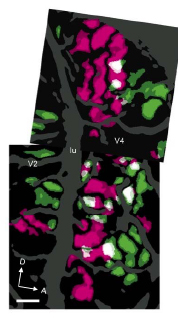
A brain area known to play a critical role in vision is divided into compartments that respond separately to different colors and orientations, Vanderbilt University researchers have discovered. The findings have important implications for furthering our understanding of perception and attention.
The research was published Nov. 14, 2010, in Nature Neuroscience.
“In vision, objects are defined by both their shape and their surface properties, such as color and brightness. For example, to identify a red apple, your visual system must process both the shape of the apple and its color,” Anna Roe, professor of psychology and co-author of the new research, said. “Our study showed that in V4, which is a brain area that plays a role in visual object recognition, there is significant segregation of color/brightness and shape processing regions.

“We also found that processing regions come in different flavors,” she continued. “There are
color processing domains, for example, for purple, green and yellow. Shape processing domains come with preference for different orientations, such as horizontal or vertical. This is a functional segregation that has never been seen before in V4.”
The researchers made their discovery by examining V4 in awake macaque monkeys. V4 was already known to play a key role in shape and color perception, but uncertainty about its organization has led to debates among researchers about the overall role it plays in vision.
“One reason this segregation is important relates to visual attention. For example, in your multicolored world, you can easily pick out a purple object if you’re looking for it. How does your brain direct your attention to only purple? The fact that there are purple domains in V4 that are distinct from green or yellow domains gives us a handle on the specificity with which we can focus our attention,” Roe said. “These domain-based ideas about how attention is implemented in the brain are exciting directions that we are currently investigating.”

The researchers speculate the compartmentalization may reflect groups of neurons that are processing more complex aspects of color and form, such as integrating different contours that are the same color, to achieve overall shape perception.
Though V4 is segregated, the different areas do work together to process information.
“Functional segregation does not mean that shape and surface information do not interact. What it means is that there are distinct circuits for color vs. shape,” Roe said.
The researchers obtained their data by using novel imaging methods that will open up new ways of studying cognitive functions such as attention and memory and new ways to study behavior. The team is the first to be able to obtain images that allow the viewer to see the different cortical organizations in awake, behaving monkeys.
Hisashi Tanigawa, research associate in the Department of Psychology, was the paper’s lead author. Haidong D. Lu, now a researcher at the Institute of Neuroscience, Chinese Academy of Science, was a co-author.
Grants from the National Institutes of Health, Vanderbilt Vision Research Center and Vanderbilt University Center for Integrative and Cognitive Neuroscience supported the research.